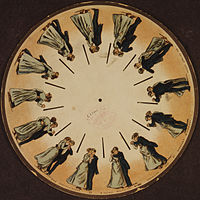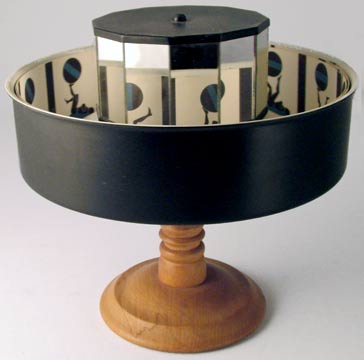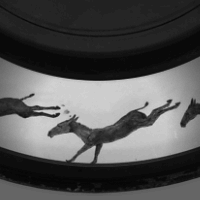Joseph Plateau:
Joseph Antoine Ferdinand Plateau was a Belgian physicist. He was the first person to demonstrate the illusion of a moving image.
The Phenakistoscope was an early device which produced a moving image, the device consisted of a spinning disk which used a spinning disk of images which where in sequence so that when the disk was spun it ould appear that the image was moving although it was only an illusion. w
 |
| A Phenakistoscope in motion |
 |
| Phenakistoscope disk |
Although the idea behind the Phenakistoscope had first been recognized by a Greek mathematician Euclid and later in experiments by Newton, it was not fully recognized and established until 1829 by Belgian Joseph Plateau. Plateau planned it in 1839 and invented it in 1841.
William George Horner:
William George Horner was a British mathematician; he was a schoolmaster, headmaster and school keeper, proficient in classics as well as mathematics, who wrote extensively on functional equations, number theory and approximation theory, but also on optics. He invented the Zoetrope.
William George Horner was a British mathematician; he was a schoolmaster, headmaster and school keeper, proficient in classics as well as mathematics, who wrote extensively on functional equations, number theory and approximation theory, but also on optics. He invented the Zoetrope.
The Zoetrope is a small circular device that produces the illusion of motion by displaying a sequence of drawings or photographs showing progressive phases of that motion.


The Thaumatrope:
There is no real inventor behind the Thaumatrope as lots of people made these as a toy during the 19th century as toys.
The Thaumatrope was a disk attached to two pieces of string with an image on either side, when the strings were spun, it would appear the two images would of merged together.
Thomas Edison:
Thomas Alva Edison was an American inventor and businessman. He developed many devices that greatly influenced life around the world
The Kinetoscope is an early motion picture device. The Kinetoscope was designed for films to be viewed by one individual at a time through a peephole viewer window at the top of the device. The Kinetoscope was not a movie projector but introduced the basic approach that would become the standard for all cinematic projection before the advent of video, by creating the illusion of movement by conveying a strip of perforated film bearing sequential images over a light source with a high-speed shutter.

Charles-Émile Reynaud:
Charles-Émile Reynaud was a French inventor, responsible for the first projected animated cartoons and for creating the Praxinoscope in.
The Praxinoscope was an animation device. It was invented in France in 1877 by Charles-Émile Reynaud. Like the zoetrope, it used a strip of pictures placed around the inner surface of a spinning cylinder.


Eadweard James Muybridge:
Eadweard James Muybridge was an English photographer important for his pioneering work in photographic studies of motion, and early work in motion-picture projection. He was responsible for creating the Zoopraxiscope.
The Zoopraxiscope is an early device for displaying motion pictures. Created by photographic pioneer Eadweard Muybridge in 1879, it may be considered the first movie projector. The zoopraxiscope projected images from rotating glass disks in rapid succession to give the impression of motion.

Lumiere Brothers:
The Lumière brothers, Auguste Marie Louis Nicolas and Louis Jean are credited to be the first filmmakers in history. They patented the cinematograph, which contrary to Edison's "peepshow" kinetoscope, the former allowed viewing by multiple parties at once, like current cinema. "Lumière" is French for "light".
A cinematograph is a motion picture film camera, which also serves as a film projector and printer. It was invented in the 1890s by the Lumiere Brothers.

George Melies:
Georges Méliès was a French illusionist and filmmaker famous for leading many technical and narrative developments in the earliest days of cinema. Méliès, an innovator in the use of special effects, accidentally discovered the substitution stop trick in 1896, and was one of the first filmmakers to use multiple exposures,time-lapse photography, dissolves, and hand-painted color in his work.
Music Videos
The animation used in this is stop motion, some of it is painted, some is real, and some of it is hand drawn. Tame Impala's music video uses painting for its stop motion
Movies
Team America (2004): This sort of animation is made by the use of marionettes (puppets).
Iron Giant: The animation used in this is Stop-motion with drawings.
TV Programmes
South Park: This Program uses cut out animations, this is where shapes are cut out of paper or material to make a certain object like a human and is then animated using the same sort of animation as stop motion.
Creature Comforts: This is made by using models made out of clay, otherwise known as 'Claymation'. g
- George Melies (optional)
- Willis O'Brien
- Ray Harryhausen
- George Pal
- Phil Tippett
- The Brothers Quay
- Tim Burton and Henry Selick
- Otmar Gutmann
- Aardman (Nick Park)
- Adam Shaheen (Cuppa Cof
Willis O'brien
Willis Harold O'Brien was
an American motion picture special effects and stop-motion animation pioneer, he particularly worked with models and figures,
who created some of the best-known images in cinema history, and is best credited for his work
on The Lost World (1925), King Kong (1933) and Mighty Joe Young (1949),he won the 1950 Academy Award for Best Visual Effects for this.
Ray Harryhausen (June 29, 1920 – May 7, 2013)
Raymond Harryhausen
was an American visual effects creator, writer, and producer who created
a form of stop-motion model animation known as "Dynamation."
His best known work include the animation on Mighty Joe
Young (1949) this won an Award for Best Visual Effects. The 7th Voyage of
Sinbad(1958), which was his first color film and Jason and the Argonauts
(1963). His last film was Clash of the Titans (1981), after which he retired.
George Pal (February 1, 1908 – May 2, 1980)
George Pal was a Hungarian animator and film producer, who was associated
with the science fiction genre. He was nominated for Academy Awards in the category Best
short subjects of cartoon, for seven consecutive years (1942–1948) and
received an honorary award in 1944. George Pal animated puppets 'Puppetoon'.
Phil Tippet (1951-Present)
Phil Tippett is an American movie director and a visual effects supervisor and producer,
who specializes in creature design and character animation.
Films Phil Tippet has created creatures and animated characters in are below: (Quoted from Wikipedia)
The Brothers Quay (born June 17, 1947 - Present)
Stephen and Timothy
Quay are American identical twin brothers
better known as the Brothers Quay or Quay Brothers. They are stop-motion animators. They are also the recipients of the 1998 Drama Desk
Award for Outstanding Set Design for their work on the play The Chairs.
The Brothers Quay have worked on these films: (Quoted from Wikipedia)
Tim Burton (August 25, 1958) and Henry Selick (November 30, 1952)
Henry Selick (born is an American stop
motion director, producer and writer who is best known for directing The
Nightmare Before Christmas, James and the Giant Peach and Coraline.
Timothy Walter or Tim Burton is an American film director, producer, artist, writer, and
animator.

He is known for his dark, gothic, macabre, and quirky horror and
fantasy films such as the horror comedy fantasy Beetlejuice (1988), the romantic
dark fantasy Edward Scissorhands (1990), the musical fantasy-thriller The
Nightmare Before Christmas (1993), the comedy-drama biopic Ed Wood (1994), the
fantasy adventure Sleepy Hollow (1999), the animated fantasy Corpse Bride
(2005), the musical horror film Sweeney Todd: The Demon Barber of Fleet Street
(2007), the horror comedy Dark Shadows (2012) and the animated horror comedy
Frankenweenie (2012).
Otmar Gutman (April 24, 1937 - October 13, 1993)
Otmar Gutmann was a
German television producer, animator, and director. He is well known for his long-running creation called Pingu. He is an animator of 'Claymation' this is where people animate characters and objects using pieces of clay, such as Pingu which he created.

Aardman Animations
Aardman Animations is a British animation studio based in Bristol, United
Kingdom. The studio is known for films made using stop-motion clay animation
techniques, particularly those featuring Plasticine characters such as Wallace and
Gromit.
After some experimental computer animated short films in the late
1990s, beginning with Owzat (1997), they created Flushed Away (2006). Aardman films have made $926 million world wide and an average of $154 million per film. All of their stop motion films are along
the highest grossing stop motion film with Chicken Run being their top grossing
film as well as the highest grossing stop motion film of all time.
Adam Shaheen (October 13, 1964 - Present)
Adam Shaheen is a
British animator, television producer and screenwriter. He is the founder and
owner of Cuppa Coffee Studios where he develops and produces all of the shows. He is also the executive producer of Cuppa Coffee’s award
winning broadcast design and commercial studio.




Bruce,
ReplyDeleteYou have made a good start here and covered everything needed to pass. You have written about some specific examples and kept only relevant information, which shows an ability to consume and interpret information.
To get a merit and above you need to say what animation each pioneer and developer is famous for and provide images (it's the last section that needs work). You also need sources throughout of a reference list.
Ellie